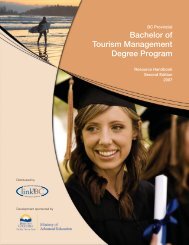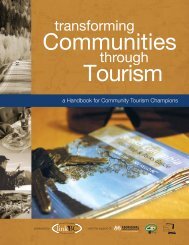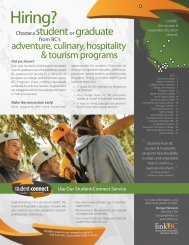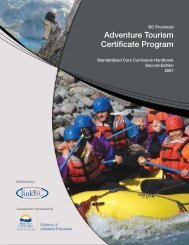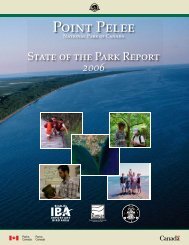Cultural Heritage Tourism Handbook - LinkBC
Cultural Heritage Tourism Handbook - LinkBC
Cultural Heritage Tourism Handbook - LinkBC
- No tags were found...
Create successful ePaper yourself
Turn your PDF publications into a flip-book with our unique Google optimized e-Paper software.
40<strong>Cultural</strong>/<strong>Heritage</strong> <strong>Tourism</strong>: Who’s InvolvedThis diagram shows the wide range of stakeholders—andpotential collaborators—thatcan be involved in your community’s cultural/heritage tourism strategy.1. Visitor or Resident:the audience for cultural tourism activities & products.2. Operators (Ops):directly interact with visitor/resident.3. Sector Groups:operator interest groups.4. Governments:agencies with related mandates.5. Social Sectors:broad segments of society.CultureFederal, Provincial AgenciesCulture OpsProvincial Arts CouncilsVisitor/Resident1CommunityNational, Provincial, Local DMOsIndustry & Sector Groups<strong>Tourism</strong> OpsBusiness OpsCofC’s, BIA’s, EcDev GroupsFederal, Provincial, Local & FN Govt’s23<strong>Tourism</strong>456.5 Work Respectfully with First Nations, Métis and Inuit CommunitiesAcross Canada, cultural/heritage tourism visitors want to experience the rich cultures of the originalpeoples of the land. Many enjoy participating in an authentic First Nations, Métis or Inuit (Aboriginal)tourism experience. Working with local Aboriginal communities, both rural and urban, should bea priority for your regional cultural/heritage tourism strategy.Aboriginal communities want to tell their own stories in their ownvoice. Many communities are taking the lead in developing culturaland heritage tourism opportunities that present authenticexperiences for the visitor and preserve their unique cultures andheritage. Through greater financial stability, stronger governance, andsavvy entrepreneurs in Aboriginal communities, a full-scale markethas emerged. Here are suggestions for working with Aboriginalcommunities 51 :• Build positive relationships. Recognize the unique relationshiplocal groups have to the land (deriving from the ancestralspirits who created the land) and the cultural knowledge thatis tied to this relationship.• Demonstrate responsibility. Acknowledge the culturalobligations of the local indigenous community for lookingafter the environmental, cultural, and spiritual well-being ofthe land.• Include First Nations partners. Ensure groups operatingwithin the traditional territory meet with leaders/elders toget input into planning. Developers should discuss theirplans and review the details of any site plans and prospectiveoperations with First Nation(s).• Think of future generations. <strong>Cultural</strong> tourism developmentmust contribute to long-term sustainability—for future generationsof Aboriginal people hosting visitor activities.• Determine what needs to be protected. The protection oftraditional knowledge, as well as spiritual, archaeological, andother heritage sites must be explicit within the plan.• Consider the land. Environmental protection of landscapesand view-scapes—for locals and visitors—are critical factorsin the process.• Develop agreements and protocols. Take time to understandthe local processes and protocols; ensure discussionsand management agreements are maintained with elders/traditional knowledge keepers. Determine who you shouldbe speaking with.• Respect local First Nations’ values in your strategy.In cooperation with the local First Nations community,include the management and protection of core values andencourage best practices while operating within traditionalterritory. Adhere to these values:• Ensure deals with First Nations are visibly and obviously ‘fair’to all parties.• Promote employment and benefits for local First Nations’communities.• Understand and share traditional ecological knowledge, andwhat it means to the community.• Identify and carefully manage, often by avoidance, all spiritualareas, sensitive archaeological sites, and heritage resources.• Carefully manage, generally by techniques to control visitorimpacts, the natural landscape, wildlife and culturally-importantplants (medicinal plants, berries etc.).An understanding of these principles can lead to strong healthyworking relationships based on respect and recognition – andultimately a richer experience for the cultural/heritage tourism visitor.46• Show respect. Demonstrate your understanding that culturalknowledge is the responsibility of elders, and that notall information may be appropriate for sharing with visitors.• Remember authenticity. Work with the local community toensure all Aboriginal cultural tourism offerings and stories areauthentic.You’ve prepared your people, and now that you’re ready to welcomeguests, it’s time to evaluate what kind of community they’ll bevisiting. The next chapter relates the process of preparing your places.47



